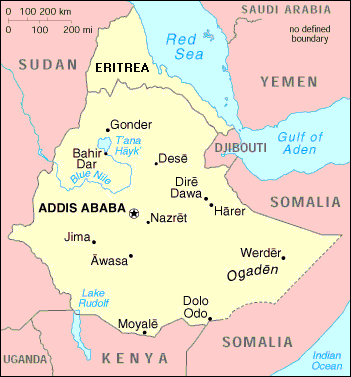

Status Quo Side: Ethiopia
Non-Status Quo Side: Eritrea
Region: Africa
Conflict Type: Primarily Internal
Issues in Dispute: Ethnic Independence
In 1952 the UN created a federation that joined British-occupied Eritrea to Ethiopia, which had been an Italian colony since 1890. Ethiopia gained an advanced economy and long seacoast. In 1962 Emperor Haile Selassie terminated the federation. Secessionist movements among exiles attracted radical Arab and communist support but remained fragmented along ethnic and religious lines. Economic depression in Eritrea after closure of the Suez Canal in 1967 swelled guerrilla bands.
Loosely united under the Eritrean Liberation Front (ELF), guerrilla bands received Soviet and Chinese arms via South Yemen and Sudan, while Cuba, China and the PLO offered training. Clashes between conservative Muslims and mostly Christian Marxists limited insurgent effectiveness, which weakened further when China ended aid after receiving Ethiopian recognition and Sudan broke its Soviet ties. After 1972 the Marxist wing (ELPF) gained ascendancy over the ELF. Stalemate in Eritrea hastened Selassie's downfall. General Aman Adom became head of state and initiated efforts for peace.
The murder of Adom by Lt.Col. Mengistu Haile-Mariam triggered a violent leftward turn by insurgents. When Soviet-backed efforts to incorporate Eritrea and the Ogaden in an Ethiopia-Somali federation failed after Somalia invaded Ethiopia in 1977 [see OGA], the USSR abandoned Somalia and Eritrean insurgents and sent massive arms and 20,000 Cubans to aid Mengistu, who regained most of Eritrea.
An ELPF rally with support from Egypt, Saudi Arabia and Sudan, led to political paralysis. The Eritrean insurgency plus economic restructuring brought on acute famine in 1984-85 and refugee flows to Sudan.
Eritrean forces won a major victory. Ethiopian counterattacks in May 1988 were repelled. Further insurgent success triggered a failed coup attempt in May 1989 by soldiers seeking peace. Under Soviet pressure for peace, two major groups and Mengistu met with former US President Jimmy Carter in Atlanta but talks were discontinued by the insurgents in December.
US mediation of formal peace talks led to agreement in July 1991 on a transitional government and Eritrea's right to a UN-supervised referendum on independence in 1993.
Eritrea became a distinct political unit. An April 1993 referendum supported secession.
Ethiopia recognized Eritrea as an independent and sovereign state.
Since independence Eritrea has asserted territorial claims against Sudan, Djibouti, Yemen and Ethiopia. In May 1998 Eritrea, locked in a currency squabble with Ethiopia, accused it of illegally occupying the 150 square mile Yigra Triangle in northwest Ethiopia and sent troops to the undemarcated border. Heavy fighting broke out in June with hundreds of casualties. On June 15 Ethiopia agreed to a US-Rwandan peace plan and later in June the OAU authorized four African states to try to mediate the conflict.
With heavy fighting breaking out again in February, 1999, the war continued to sap the economies of both sides, particularly as famine again threatened Ethiopia. In April 2000 Prime Minister Meles and Eritrean leader Issaias Afwerki, agreed to talks in Algiers backed by Washington and the OAU.